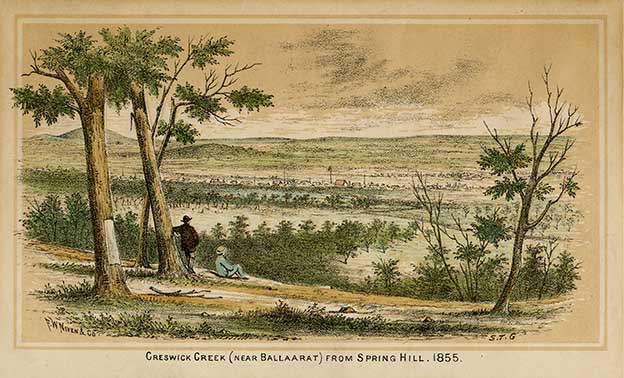John Keenan
Contents
Background
John Keenan was born at Parsontown, King’s County, Ireland in 1835.[1] His parents were William Keenan and Mary Roche. He arrived in Victoria in 1852.[2] John Keenan married Anne Keogh (1840-1903)[3] in Melbourne. He died on 26 September 1898, and was buried at Majorca Cemetery.[4]
Grave Stome Inscription: Sacred to the Memory of JOHN KEENAN Native of King's Co. Ireland Who died 26th Sep 1898 Aged 63 years.
Also of his beloved wife ANNE Native of Tipperary, Ireland Who died 6th June 1903 Aged 63 Years
R.I.P
Erected by their loving daughter.[5]
Goldfields Involvement, 1854
John Keenan was mining at Creswick in 1854. He was among the Creswick miners who joined the stockaders at Eureka. Keenan was present in the Eureka Stockade on 03 December 1854 and was shot in the leg early during the battle. Some insurgents carried him to where some horses were tied up hiding Keenan among the litter between the horses and the manger. He was not discovered in this hiding place.[6]
Post 1854 Experiences
Obituary
- SEPTEMBER 30, 1898. - Mr John Keenan, the well-known farmer, of Majorca, whose death was announced in our last issue, was born at Parsontown, King’s County, Ireland in the year 1835, and was therefore 63 years of age at the time of his death.
- When only 17 years of age he left his native land in the ship Hibernian and arrived in Victoria in 1852. His first employment was as a stonemason’s labourer at Geelong, his wages being 30s a day. He, however, only remained a few weeks, and departed for the goldfields. He afterwards worked on most of the large alluvial goldfields and was one of the miners who fought in the memorable battle of the Eureka Stockade, where he received a bullet through his right leg. Mr Keenan often related with pleasure the part he took in the riot.
- Just previous to this battle, he and his mate were working on Clarke’s Flat near Creswick. About sunset, Mr Keenan, who was on the surface, was stooping down examining some wash-dirt, when he suddenly received a blow on the back, which nearly knocked him down. Looking up he saw a trooper with a drawn sword, and further away a large body of mounted men. “Have you a licence?” asked the trooper, “Yes” replied Keenan. “Show it.” “Well, to tell the truth, the hole we are working is rather wet, so I left my licence in my tent.” “Where is your tent?” again asked the trooper. “Oh! That one,” said Keenan, pointing to one very close to a dense scrub.” “Well, march,” said the trooper, “and show it to me.” Keenan accordingly walked towards the tent, and when just about to enter, darted suddenly into the scrub. He knew the trooper could not follow him on the horse, and on foot he was a match for any of them. The trooper commanded Keenan to halt or he would fire on him. “Oh, fire away,” was the retort, which invitation was not accepted by the trooper, who, seeing the game was out of reach, called out as he wheeled his horse around, “See you have a licence next time I come.”
- That night, Mr Keenan and his mate started for the Stockade fully armed. On the road they were surprised by some troops and Keenan’s mate was taken and unarmed, but Keenan arrived safely in the Stockade. Early in the battle he was shot with a rifle bullet through the right leg, and was shortly afterwards carried by miners and his in a quantity of litter between the front feet of some horses and the manger at which they were feeding. Next day a man with a horse and dray was paid £14 to convey him to the Geelong Hospital. Shortly after the journey was commenced (which occupied three days) they were stopped by a party of troopers, who in reply to their questions as to what was wrong, were told the injured man had fallen down a shaft. This was believed and the troopers departed. Mr Keenan spent 21 weeks in the Geelong Hospital, and 11 pieces of bone were taken from the fracture.
- About 33 years ago he settled on a block of land at Sandy Creek, Majorca, and since that time was chiefly engaged in farming pursuits, but always had a weakness for mining. He was exceedingly industrious, and trustworthy and honest to the utmost degree. He was widely known, and highly respected by all classes of the community.
- A few weeks since he was attacked with influenza; bronchitis and congestion and inflammation of the lungs supervened, and despite the unremitting attention of his medical adviser, Dr Garde, and the constant and careful nursing of his family, he passed away on Monday morning.
- Deceased leaves a widow and family of four to mourn the loss of an affectionate husband and father.
- The respect in which the deceased was held by the residents of the district in which he lived so long was fully testified by the large number who followed his remains to their last resting place in the Majorca cemetery on Wednesday afternoon. The pallbearers were: -Messrs J. Kenny (Williamstown), J. Maher (Bowenvale), P. F. Walsh, Jno. Williams, J. Manning, and P. Maher. The service at the grave was conducted by the Rev. Father Lynch, and the mortuary arrangements were carried out by Messrs T. Casey and Son, of Maryborough.[7]
See also
Further Reading
Corfield, J.,Wickham, D., & Gervasoni, C. The Eureka Encyclopaedia, Ballarat Heritage Services, 2004.
References
- ↑ Obituary, 30 September 1898.
- ↑ Sydney Daily Telegraph, 28 September 1898.
- ↑ https://www.findagrave.com/cgi-bin/fg.cgi?page=gr&GSln=keenan&GSiman=1&GScid=2431594&GRid=129905509&, accessed 03 October 2017.
- ↑ Death certificate in the possession of Mac Keenan.
- ↑ https://www.findagrave.com/cgi-bin/fg.cgi?page=gr&GSln=keenan&GSiman=1&GScid=2431594&GRid=129905509&, accessed 03 October 2017.
- ↑ Blake, Gregory, To Pierce the Tyrant's Heart, Australian Military History Publications, 2009, p.177.
- ↑ Obituary, 30 September 1898


